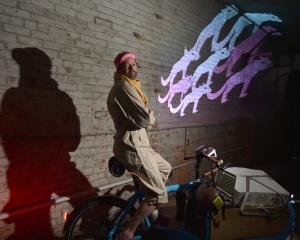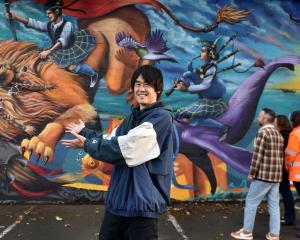
Otago Potters Group ''Annual Exhibition 2014'' (Community Gallery)
With ceramic art thriving locally and internationally, the annual exhibition of the Otago Potters Group is an excellent opportunity to view the work being produced throughout the region.
There are over 150 pieces on display at the Community Gallery in Princes St, all of them sensitively finished and arranged with an instinctive feeling for pattern and colour.
Items veer from the very classical and traditional to the more abstract and whimsical, and the mingling of styles works well.
Artists of all ages have contributed to the selection, drawing on different influences and life experiences to direct their imagination.
The crystalline glazed bowls of guest artist Peter Gregory are beautiful. Fired between 1280degC and 1300degC, the result is an immense depth of colour and tiny, detailed variations in surface texture.
Group member Liz Fea is a ceramic milliner: her Race day beauties are festive, bedazzled little vessels topped with gorgeous hat and fascinator-inspired constructions that wouldn't be out of place at Ascot.
The glossy lines and serene tones of Judy Ringland-Stewart's tableware and vases are eye-catching and appealing, and Danny Moorwood's lustre glazes are always impressive.
The purely sculptural works are as striking and memorable as the more functional pieces, particularly Bronwyn Mohring's poignant One string left to bow, Garry Goh's sinuous, lovely Twirl and Phyllis Smith's Wahine figures, which have a presence that belies their size.

''Harbour'', Sam Foley (The Artist's Room)
Sam Foley's 20th solo show is one of the year's must-see exhibitions.
After a residency in Switzerland, Foley has returned to his home town, finding continuous inspiration for his urban landscapes.
The 12 large-scale paintings of ''Harbour'' depict everyday scenes around Otago Harbour and the back streets of Dunedin.
Foley has the most remarkable ability to replicate the effects of light.
Its luminosity and transformative qualities are all captured on canvas with such clarity that it seems possible to determine the exact time of day or night by the fall of shadow.
The oil paint glows from within as if it has captured the rays and is projecting them outward.
The treatment of light has a very strong emotive effect: the viewer feels cold or warm, reminiscent and cosy or vaguely apprehensive and alert.
Even without an explicit human presence, there is always a sense of life beyond the picture plane; the expectation of footsteps, distantly echoing in the street scenes, or faces just out of sight of the windowpanes.
This is taken a step further with the installation art pieces, where video footage is projected on to the canvas.
It works particularly well with Intersection, the star of the show. Foley paints the five-street intersection in Port Chalmers as a slightly eerie ghost town, still and quiet in the lamp-lit night.
When the video plays, the township stirs: lights flicker, engines rev, and the occasional shadowy wraith of a car comes down the street and turns the corner.

''Very New Paintings'', Mervyn Williams (Milford Galleries Dunedin)
Mervyn Williams is as much an optical illusionist as he is a painter.
His experiments with perspective and perception - testing and teasing the difference between what our eyes see and what our mind tells us must be - began early in his career.
His recent collection of ''Very New Paintings'' both builds upon and diverges from the work he has produced since his student days at Elam in the 1950s.
The introduction of digital art elements has allowed for new intricacy of pattern and manipulation of space, while also bringing the works firmly into the technological age.
People have digitised their lives to an extent, and Williams has always followed the modernist aesthetic in his belief in the new, the rebellious, and the process of constant reinvention.
Williams wants his art to transfix and puzzle, to cause viewers to wonder how something has been done, not to instantly assimilate the image and move on.
However, it is not elitist art; it is easy to engage with the canvases, to be intrigued by the discord between the flat surface plane and the magic that happens between the eye and the mind.
It is rather like looking at a ''magic eye'' book: at first glance, there are straightforward geometric patterns; after a prolonged stare or through a camera lens, things can become deceptively kinetic.
Circles bend, straight lines converge, and the whole image can start to ''shiver'' and appear to vibrate.
The optical play is slightly disconcerting, and fascinating.
-by Laura Elliot









![... we all become all of these things [installation view] (2025), by Megan Brady.](https://www.odt.co.nz/sites/default/files/styles/odt_landscape_small_related_stories/public/story/2025/03/1_we_all_become_all_of_thes.jpg?itok=nicA_yAm)


